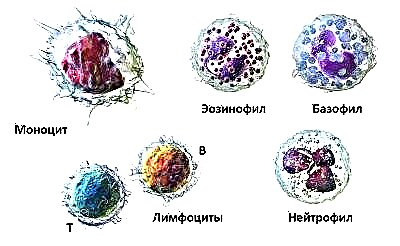
The number of white blood cells is of great importance for the detection of various diseases in a child. Therefore, parents should know how many leukocytes should be normal in babies, what is leukocytosis in the blood of a child and why the number of such cells may decrease.

The role of leukocytes and their types
Leukocytes or white bodies is a group of blood cells that protect the child's body from various external influences. Unlike other blood cells, leukocytes are heterogeneous and are represented by different types:
- Neutrophils are the most numerous group of leukocytes with granules, a feature of which is the presence of forms at different stages of maturation (young, young, mature). The main task of such cells is to fight bacteria, and based on an assessment of the ratio of forms of neutrophils, one can judge the presence of various pathologies.
- Eosinophils are represented by cells, which also have granules. Such leukocytes are designed to protect the child's body from allergens, as well as from parasites and protozoa.
- Basophils are less abundant than other granular leukocytes. The main task of such cells is the release of biogenic amines into the blood in order to ensure certain immune responses.
- Lymphocytes are a large group of granule-free leukocytes that are essential for immune responses. These cells protect the child from viral infections.
- Monocytes are a type of leukocyte without granules that can absorb bacteria, dead cells and other substances in order to remove them from the child's body (they become macrophages).
- Plasma cells are the least numerous group of leukocytes whose task is to form antibodies. Such white bodies are normally found only in children.

What affects the number of leukocytes
White blood cell counts can vary depending on:
- Age. The maximum number of leukocytes in the bloodstream is observed in a newborn, and as the baby grows, their number gradually decreases. That is why, for the correct interpretation of a blood test, it is important to know the age of the child, because, say, the results at 5 months, at 2 years or at 3 years will differ.
- Physical activity of the child. After exercise, such as active play or running, the number of leukocytes will briefly increase. Also, their increase can be due to emotional stress.
- Food intake. Within a few hours after it, the child will be diagnosed with leukocytosis.
- The presence of various diseases. In some pathologies, the number of leukocytes increases (sometimes several times), while in others it decreases.
How is the number of leukocytes determined?
Determination of the number of white blood cells occurs during a clinical blood test simultaneously with the calculation of the number of erythrocytes, platelets, determination of hemoglobin level, ESR, hematocrit and other indicators. Blood for this test is often taken from a fingertip, but in some cases venous blood is assessed, and in a newborn baby, blood can be drawn from the heel.

The number of different types of leukocytes is determined separately and displayed as a percentage, which is called the leukocyte formula. Its assessment helps in the diagnosis of specific diseases, because in some diseases there will be an increase in neutrophils, in others there will be more eosinophils, and some diseases are characterized by an increased number of lymphocytes. However, first of all, the doctor will assess the total number of leukocytes, therefore, we will focus on its changes.
How to get tested
In order for the leukocyte count as a result of the analysis to correspond to the real picture, it is important to consider the following points:
- A child should not eat for at least 8 hours before donating blood, and if it is a baby, then the break from feeding to blood sampling should be at least 2 hours.
- The child should not be allowed to run before the test. It is best to come to the clinic in advance and sit quietly in the corridor for 10-15 minutes before taking blood.
- Try to calm your child so that he does not worry before donating blood and does not cry, as emotional stress affects the results.
- Do not let the temperature drop, so you should not go into the office to donate blood immediately after you came to the clinic from the street.
Table by age
The number of white blood cells in normal children of different ages is represented by the following indicators:

Leukocytes above normal
If many leukocytes have been identified in the blood test and the indicator exceeds normal, this condition is called leukocytosis. It happens both with diseases and with the influence of some external factors that do not pose a danger to children. Also important for assessing leukocytosis is to determine its severity, since it is directly related to the activity of the pathological process.
In the next video, Dr. Komarovsky will try to answer the question of what an increase in leukocytes in a blood test means.
Causes of leukocytosis
As noted above, a large number of white blood cells can be observed in non-hazardous conditions, for example, after exercise, stress, crying, fright, hot baths or eating. Pathological leukocytosis in children is diagnosed:
- With bacterial infections, for example, with angina or pneumonia.
- After operations, for example, with appendicitis.
- With a chronic inflammatory process in the child's body, for example, with arthritis or intestinal inflammation.
- With viral infections, for example, with hepatitis, ARVI, rubella, HIV infection and others.
- For allergies.
- With fungal infection, as well as parasitic invasions.
- With autoimmune diseases.
- After injuries or extensive burns.
- With oncological pathologies.
- With hemolytic anemia or severe blood loss.
- After removing the spleen.
- When the bone marrow is affected by various factors.
- After using certain medications, for example, hormonal or immunostimulating.

Symptoms of leukocytosis
In many children, leukocytosis is manifested by fever, decreased appetite, weakness, dizziness, sweating, fatigue, poor sleep, sore joints and muscles, weight loss and other symptoms characteristic of infectious diseases, poisoning, cancer, chronic inflammatory diseases and other pathologies, accompanied by high leukocytes.
How to reduce white blood cell count
If leukocytosis is detected in a blood test, the doctor will send the child for additional examinations, because this condition is a sign of the presence of an inflammatory process in the child's body. Once the cause of the high white blood cells is found, the baby will be prescribed the right treatment, and when the baby is well, the white blood cell level will return to normal.
Leukocytes below normal
If it is noted on the blood test form that there are fewer leukocytes than it should be at this age, this is called leukopenia. This condition rarely occurs in healthy children and often indicates the presence of some kind of disease. The main danger of leukopenia is the weakening of the defenses of the child's body, because there are not enough leukocytes capable of fighting viruses, parasites, allergens, bacteria and other harmful factors.

Causes of leukopenia
A decrease in the number of white blood cells is observed:
- With hypovitaminosis, exhaustion or starvation.
- With bacterial infections.
- After poisoning.
- Due to the intake of certain medications, for example, cytostatics, antibiotics, anticonvulsants, steroid hormones, and other drugs.
- With viral infections, such as rubella or chickenpox, especially during the recovery period.
- Due to damage to the bone marrow by radiation, medications, genetic disease, tumor, autoimmune disease and other factors.
- With a decrease in blood pressure.
- For tumors, such as leukemia.
- With systemic diseases, including lupus erythematosus.
- With anaphylactic shock.
- With hypothyroidism and diabetes mellitus.
- With increased activity of the spleen.

Leukopenia symptoms
There are no characteristic signs of leukopenia, however, such a condition threatens the child with "joining" an infection, which will manifest itself with fever, tachycardia, weakness, swollen lymph nodes, headaches and other symptoms.
What to do
If leukopenia is accidentally detected, the child should be additionally examined. If the indicator is slightly reduced and this is associated with hypovitaminosis, therapy is limited to the use of vitamin preparations and diet correction. If a serious illness is found, the child is prescribed appropriate treatment. For some time after recovery, the number of leukocytes is restored to the age norm.

By watching the following video, you can find out more about how important leukocytes in the blood are and what deviations from the norm are fraught with.



